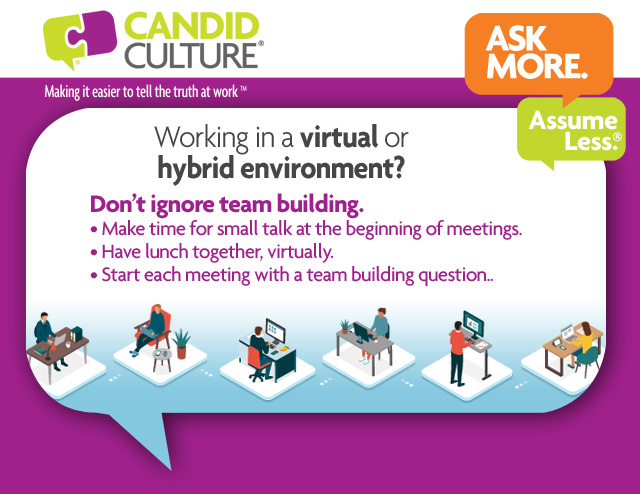Posts Tagged ‘hybrid work environment’
Hybrid meetings are more complicated and more difficult to run. There are lots of pitfalls. But with advanced planning and preparation, hybrid meetings can be well run and efficient.
Hybrid meetings defined: Some participants are together in-person, other participants attend from different locations.
Some pitfalls of hybrid meetings:
- Can the people attending virtually hear people who are attending in-person, from a conference room?
- Are the people in the conference room ‘talking’ to each other with their eyes while the virtual attendees assume they’re ‘talking’ about them?
- Are people participating equally, regardless of their location (not unique to hybrid meetings)?
- Are people texting each other about their real thoughts versus saying them out loud (also not unique to hybrid meetings)?
- Did the facilitator provide hard copies of documents to in-person attendees and forget to send documents to virtual attendees?
The keys to running effective hybrid meetings – anticipate and practice before the meetings.

Do a dry run of a hybrid meeting before you run one. I run a practice session for all hybrid trainings I facilitate, even with repeat clients and multiple sessions with the same client. It’s not worth leaving anything to chance. Have two people in a conference room and another person attend virtually. Test the sound. Move around the conference room; sit in different locations. Can the virtual attendee see and hear, regardless of where in-person attendees are sitting?
Assess if you need an external camera and microphone. Getting these items set up may feel intimidating at first, but you only need to do it once. Once the technology is set up, it’s ready to use for future meetings.
Most conference rooms – even small ones – will need an external microphone so in-person participants can be heard by virtual participants. Trust me. I’ve learned this the hard way. The microphone in your laptop won’t pick up sufficient sound for virtual attendees to hear in-person attendees. You can buy a microphone for $30 at Best Buy or Amazon.
Plan how you will elicit balanced participation from attendees in all locations. Will you call on people? Consider sharing facilitation of different topics, so people in multiple locations lead different parts of the meeting.
Set expectations for participation when meetings start – using the chat and raise-of-hands feature, microphones on or muted, no distractions, and no messaging fellow participants offline. Don’t assume people know or will follow the guidelines from past meetings. Set expectations at the beginning of every meeting, even recurrent meetings.
When breaking people into groups during hybrid meetings, it’s tempting to put people in groups based on location, putting the in-person people together and the virtual people together. This practice exacerbates proximity bias (a topic for a future blog). While it’s harder to group in-person and virtual attendees together, it is more equitable.
Cameras on or cameras off? Discuss, decide, and tell participants in advance so virtual attendees are prepared.
Talk about the pitfalls of hybrid meetings with all attendees. Tell people to avoid ‘talking’ with their eyes to fellow in-person participants. Avoid having a camera capture the side of your face while you watch a different screen. Use the blur-your-background feature in Zoom if your background is distracting.
The key to leading effective hybrid meetings? Anticipate potential breakdowns. Prepare in advance. Communicate expectations with participants. Debrief meetings after they end. Make necessary changes. Repeat.

It’s easy to forget about team building when you’re working virtually, or to think that team building can’t be don’t virtually, or to decide to wait to do team building until your whole team can get together in person. My advice; don’t wait.
Often the most meaningful aspects of work are the people we work with and the relationships we build. When you leave a job, you leave your laptop and take your friendships. You can build team work virtually, you just need to make the time.

Even if you’re type A and tightly wound (like I am), spend the first few minutes of meetings on small talk, just like you would if you were gathering in a physical conference room. Ask what people are doing for the holidays. Commiserate over vacations you’re missing and food you know you shouldn’t be eating.
Eat lunch together, virtually. Remember when people used to sit together in the office breakroom or cafeteria? Why not eat together via video? Team building doesn’t have to be elaborate. It can just be spending time together, talking about things other than work.
Humans need people contact and relationships. People are missing other people. Connections with our coworkers make us feel connected to our organizations.
Small talk and group lunches create camaraderie, but they don’t teach people how to work together. In addition to social activities, give people a chance to talk about working style preferences too. You don’t have to do personality assessments and long training programs to build teamwork. Just give people a chance to talk about how they like to work, on a regular basis.
Tell you team you want to help people get to know each other better so work gets done more easily. Start each team meeting with one of the questions below, then move on to your meeting agenda. Do this all year.
Here are a few team building questions you can use:
What are your pet peeves at work?
What time of day do you do your best work?
Do you leave your email, phone, or text alerts on at night? If I text you after hours, will you get a ping?
If I email you on weekends and evenings, do you think I expect a response? Would you prefer I send messages only during regular business hours?
What work do you like to do most?
What work do you like to do least?
What’s an area of our business you’d like to learn more about?
What’s something you’d like to learn to do that you don’t have a chance to do now?
Read a question to the group. Give everyone at the meeting the opportunity to answer the question about themselves. And remember, the meeting leader/facilitator speaks last. People will often follow the most senior person’s lead. You want people to answer authentically rather than providing what they think is the ‘right’ answer.
Team building doesn’t have to take a lot of time or money. Don’t wait until everyone is back in the office or for a future retreat. Help coworkers spend time together formally and informally, getting to know each other better now.


So much has changed in the last year and a half. And what you need to be happy at work may have changed too. The question is, do the people you work for and with know what you need now?
You aren’t likely to get what you don’t ask for, but most people don’t ask for very much. We assume that the people we work with will do the right thing without prompting. We’ll get the recognition and compensation we deserve at work because it’s the right thing to do. We’ll be included in important meetings and decisions regardless of from where we are working.
If you read this blog regularly, you already know that I’m a proponent of setting clear expectations and asking more questions before problems occur. Consider what you want and need, anticipate what can go wrong, and plan accordingly before problems happen. Doing that sounds great in theory, but how does it work in practice?

Here are five ways to increase your job satisfaction:
Increasing your job satisfaction tip one: Be honest with yourself about what you need to be happy at work. Rather than tell yourself you won’t get what you need or try to convince yourself that you shouldn’t need something, just admit your needs to yourself.
Increasing your job satisfaction tip two: Share your needs with people who can help you get those needs met. Don’t make people guess. Chances are they won’t guess at all or will guess wrong.
Increasing your job satisfaction tip three: Don’t assume things will go well and just wait and see what happens. Instead, set clear expectations at the beginning of new projects and working relationships.
Here’s how that could sound: “We’re going to be working together for the next six months. Let’s talk about how everyone likes to communicate, what people’s pet peeves are, and the kind of information each person wants to receive.”
Here’s another example of how that could sound: “I’m excited to work on this project with you. There are a few things to know about me that will help us work well together and deliver timely results. I ask a lot of questions. Let me know if this frustrates you. I’m not questioning you; I just have a need to understand why we do what we do. And I work best with a deadline. I am happy to be available off hours, but you probably won’t hear from me before 9 am. You will get messages and work from me at night and on the weekends. Just let me know if you’d prefer I schedule messages to go out during regular business hours.”
People might give you what you need if you ask, but they likely won’t if you don’t. Train others how to work with you.
Increasing your job satisfaction tip four: Agree to talk about things as they happen. Don’t wait until you’re about to explode to speak up.
That could sound like, “I want us to work well together, and things will go wrong. Can we agree that we’ll provide feedback as things happen so we can make timely adjustments?”
Increasing your job satisfaction tip five: Renegotiate when you need to. If you realize you need or want something that you didn’t ask for, go back and ask. It’s never too late.
Here’s how that could sound, “We touch base about once a month and I’m realizing that if we could talk for about 20 minutes once a week, I’d be able to get more done. Can we make that happen?”
Job satisfaction and happiness don’t just happen. The people you work with are not you and they don’t know what you need. Make a regular practice of identifying what you need, making those needs known, and then speaking up when things go awry. You won’t get what you don’t ask for, but you will get what you allow.










